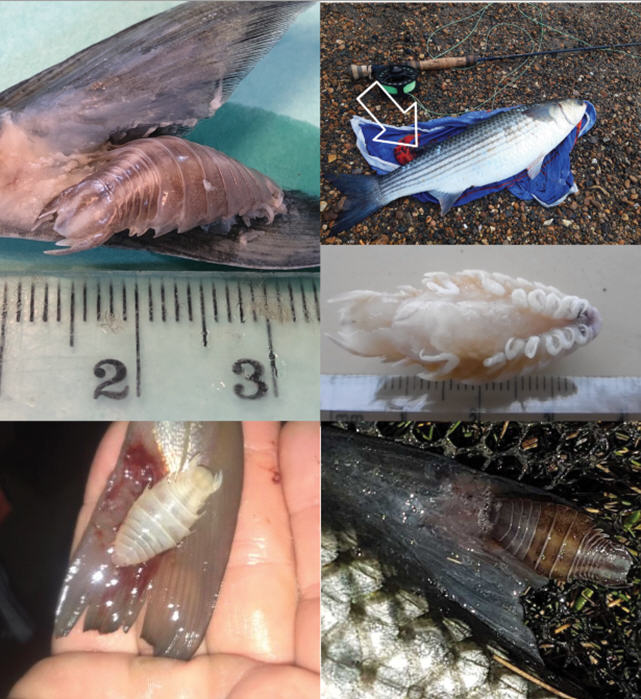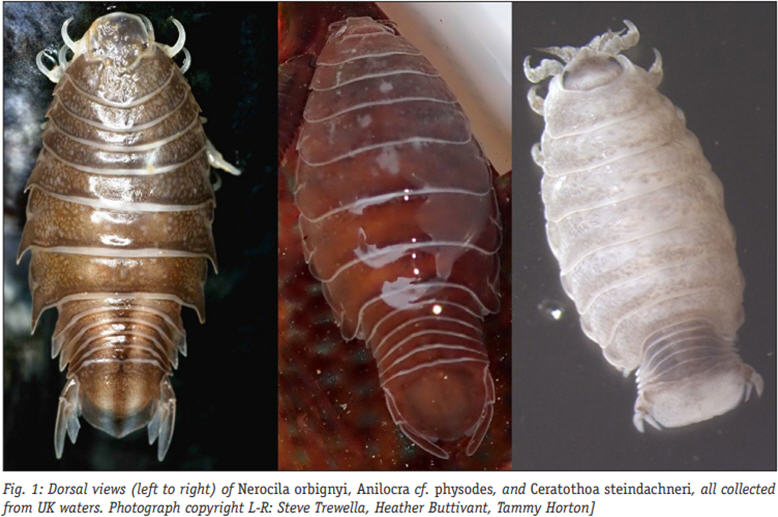|
|


|

Dr Tammy Horton is a scientist working at the National Oceanography Centre and is currently updating records of certain parasites called isopod crustaceans and would like our help! Please read Tammy's report below and feel free to share! Details of what and where to send included below. Dr Tammy Horton is a scientist working at the National Oceanography Centre and is currently updating records of certain parasites called isopod crustaceans and would like our help! Please read Tammy's report below and feel free to share! Details of what and where to send included below. |
Occasionally you will come across a fish with an unwelcome attachment, a parasite. There is a wide variety of parasites that infect fish, some cause extensive damage, and others appear to have very little effect on the host fish. An encounter with the parasites I am interested in is unlikely to go unnoticed, as they are particularly large and alien looking (see photograph). These parasites are actually isopod crustaceans (like crab, shrimps, lobsters etc), and are related to woodlice (also crustaceans!). They are known scientifically as cymothoids, a group with more than 350 species globally, and are among the largest known isopods.
They are perhaps better known colloquially as 'fish lice' or 'tongue-biters', dependent on where they are found on the fish. There are 'mouth or gill-attaching' species, which are not immediately apparent to the observer. These parasites are often encountered by fishermen, anglers or fishmongers after capture of the infected fish. On death of the host, the isopods will often crawl out from the mouth or gill cavity, to be discovered free in the net or on the deck of a boat. There are 'skin-attaching' species, which will cling onto the exterior surface of their hosts, using their powerful and wickedly sharp dactyls (claws) to pierce the host tissue and prevent detachment. They will generally attach to the host at particular attachment sites (e.g. near the tail or on the head) and this information can help in identifying the species. There is also a smaller group of bizarre 'flesh-burrowing' species, which is largely confined to freshwaters, in South America and Asia.
I first began studying them back in 1998 for a PhD at the University of Reading and at the Natural History Museum in London, researching the species we had found living inside the mouths of lesser weever fish, in Whitsand Bay Cornwall, and what impact (if any) they have on the fish. The study of this host-parasite association allowed me to map the distribution (it was confined to south west Britain). It was thought that the finding of a breeding population of the species was probably a result of a range expansion related to climate change.
It is now known that we have at least three cymothoid species in UK waters (the mouth-inhabiting Ceratothoa steindachneri, and two skin-attaching species: Nerocila orbignyi and Anilocra spp.). I have continued to receive sporadic reports on them, and in the last decade these reports have become far more frequent, resulting in a renewed interest from me in documenting as much as I can about distribution and hosts in UK waters. The majority of records are from the south west coast and the Channel Islands, with breeding populations confirmed in Dorset.
Contacts from anglers have increased the recent reports. Robin Bradley, a keen seabass angler, contacted to report a cymothoid isopod on a seabass collected by Rob Franklin in the Fal estuary, Cornwall (unfortunately no photo, so unable to confirm identification). Robin said "The angler who caught it noted that other anglers have found these in cod and whiting locally, apparently in their bellies or attached to their tongues". This and other similar anecdotal reports may mean we have an additional species in UK waters, possibly Ceratothoa oestroides, which is a known mouth inhabiting isopod, infecting seabass in the Mediterranean. I am particularly keen to see photos & specimens of any mouth-inhabiting isopods, as currently only Ceratothoa steindachneri is known in lesser weever fish populations in the UK.
So far, the known hosts of the skin-attaching species Nerocila orbignyi & Anilocra spp. in our waters (Horton & Baillie 2019; Huwae et al. 2020; Horton & McGrath, 2021) are as follows:
Anilocra spp. have been found on corkwing Wrasse (Symphodus melops); cuckoo wrasse (Labrus mixtus); goldsinny wrasse (Ctenolabrus rupestris); rock cook (Centrolabrus exoletus); ballan wrasse (Labrus bergylta); black bream (Spondylosoma cantharus); sand smelt (Atherina presbyter); two-spot goby (Gobiusculus flavescens); painted goby (Pomatoschistus pictus); pouting (Trisopterus luscus); pollack (Pollachius virens), and red mullet (Mullus surmuletus).
Nerocila orbignyi has been reported on whiting (Merlangius merlangus); thick-lipped grey mullet (Chelon labrosus); seabass (Dicentrarchus labrax); mackerel (Scomber scombrus) and herring (Clupea harengus) in British waters, and also on blue whiting (Micromesistius poutassou); smelt (Osmerus eperlanus); flounder (Platichthys flesus); and plaice Pleuronectes platessa on the Dutch and Belgian coasts (Huwae et al. 2020).
These animals are relatively rare in wild fish populations, and very difficult to collect in the numbers needed for scientific study, but I know that the people most likely to come into contact with them are fishermen and anglers. This is why I am asking for help to raise awareness and improve the recording of these wonderfully bizarre and often overlooked isopods.
If you do find one of these parasites, what should you do?? Ideally take a photograph of the parasite on the fish which can be sent to me ( tammy.horton@noc.ac.uk ) along with the following information:
- Date of capture
- Locality of capture (as specific as you can)
- Species of fish it was found on
- Where it was attached on the fish
We are particularly interested in obtaining specimens suitable for molecular analyses. If you manage to detach a specimen from the fish (this can be quite tricky!), it can be placed in a freezer and then I can organise for the samples to be collected/posted. I am happy to send the necessary containers and preservatives.
Fig. 1: Photographs of Nerocila orbignyi. Clockwise from top left: on mackerel, Galway Bay (David McGrath); on thick-lipped grey mullet, near Gosport (Tim Whiley); on seabass, offshore Weymouth (Peter Barry); on thick-lipped grey mullet, Hamble Estuary (Mark Bennett); on whiting, Tamar Estuary (Simon Toms).
Fig. 1: Photographs of Nerocila orbignyi. Clockwise from top left: on mackerel, Galway Bay (David McGrath); on thick-lipped grey mullet, near Gosport (Tim Whiley); on seabass, offshore Weymouth (Peter Barry); on thick-lipped grey mullet, Hamble Estuary (Mark Bennett); on whiting, Tamar Estuary (Simon Toms).


